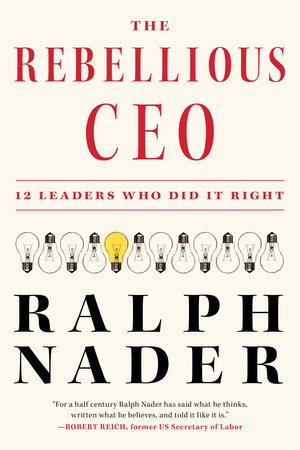The Rebellious CEO: 12 Leaders Who Did It Right
- By Ralph Nader
- Melville House
- 352 pp.
- Reviewed by Paul D. Pearlstein
- December 15, 2023
A refreshingly upbeat offering from corporate America’s longtime foe.

Beginning with his iconic Unsafe at Any Speed in 1965, Ralph Nader has written, co-authored, or edited at least 136 books. Most are highly critical of the corporate world, but his new The Rebellious CEO is a reversal. In it, he praises a dozen business leaders “who did it right.”
A longtime consumer advocate and activist, Nader has fought in the trenches against the abuses and deceptions of big business for more than half a century. His credentials are not that of a rabblerouser — magna cum laude and Phi Beta Kappa at Princeton, and a law degree from Harvard — yet his name is seldom heard in corporate boardrooms unless it’s modified by pejoratives.
In this book, however, he is mostly upbeat, revealing a very different Ralph. Here, as a “corporate professor,” Nader praises (in occasionally off-putting, redundant prose) a dozen business leaders and describes their enlightened policies. All 12 are founders of successful businesses, which means they had control and guided their companies as they saw fit. Nine of those profiled are now deceased, and it’s unclear if their successors will continue their innovative strategies.
Ray C. Anderson founded Interface, Inc., which became the largest carpet-tile manufacturer in the world. Its carpet was originally made from petroleum products, causing questions about possible environmental harm to bubble up. Anderson, a Georgia Tech engineer and lifelong student, was influenced by Paul Hawken’s The Ecology of Commerce: A Declaration of Sustainability. Spurred to rethink everything about his manufacturing process, he was able to develop a way to make his product without using petroleum.
This change — a huge, unconventional leap forward — emboldened Anderson. He became an unapologetic evangelizer for a cleaner environment, yet Interface nonetheless remained profitable. Before his death in 2011, Anderson was able to choose a successor who continues the company’s mission of sustainability.
Another trailblazer was Herb Kelleher, a New Jersey lawyer who moved to Texas and co-founded Southwest Airlines. By cutting fares and emphasizing customer service, he achieved rapid success, growing Southwest from a tiny, intrastate airline to a national carrier that managed to survive the covid-19 pandemic when many competitors did not.
Kelleher was a charismatic personality who prioritized his workers above clients. He provided stock options for all employees, which made them co-owners and gave them a voice in management. Fair compensation and a good benefits package followed. While many companies were paying multimillion-dollar salaries and bonuses to their CEOs, Kelleher kept his personal compensation below $1 million a year. He became a billionaire the old-fashioned way: through the rising value of his company’s stock.
Kelleher believed that employees were the key to successful management. Each new applicant at Southwest went through extensive interviews before being offered a job. To him, being joyful and showing empathy and intelligence were critical. If his employees were happy, he knew passengers would be, too, and the business would flourish. (Those employees were extremely loyal to their boss, evidenced by the huge number of them who traveled great distances to attend Kelleher’s funeral in 2019.)
Lifelong adventurer Yvon Chouinard launched powerhouse outdoor-gear company Patagonia after he’d learned enough blacksmithing to repair and make new pitons for himself and his rock-climbing friends. He moved the business from his home in Maine to Ventura, California, where he soon fell in love with surfing. As he expanded operations, he gave his employees longer lunch breaks and encouraged them to use the extra time to try surfing, too.
Chouinard’s initial rock-climbing offerings expanded to cover almost everything for the outdoors, including a large line of protective and colorful clothing. He eventually (and wisely) began taking back used clothing and equipment — all of it emblazoned with “Patagonia” — and turned it into an affordable line of secondhand items accessible to less-affluent customers.
He memorialized his laidback C-suite ethos in his memoir, Let My People Go Surfing: The Education of a Reluctant Businessman. This wave-riding Moses was always interested in preserving the earth; as Chouinard acquired wealth, he wanted to use it to do something more for “his” planet. So, he created a 173,000-acre land trust in the Patagonia region of southern Chile that’s open to all. He also purchased 155,000 acres called Estancia Monte Leon along 25 miles of Atlantic coastline in Argentina. The area contains a varied animal and plant population worthy of Darwin and, in 2002, became a national park. True to their beliefs, Chouinard and his family have pledged to give away their company to two trusts established to continue their conservation efforts.
These three CEOs reflect the creativity and humanity embodied by all the leaders profiled in Nader’s book. Each in their own way emphasized good works, fairness, and concern for the environment over making money. Yes, profits are necessary, but greed and bad behavior are not. Giving something back to the world is not a violation of their duty to shareholders, nor is it a breach of the “rules of capitalism.”
If The Rebellious CEO is Ralph Nader’s swansong, it is a cheerful, hopeful, almost patriotic one. Does it mean big business’ loudest critic is mellowing as he approaches 90? Perhaps, but even if not, its optimistic theme is a lovely surprise from America’s most tenacious corporate-dragon slayer.
Paul D. Pearlstein’s late father-in-law, Lowell, graduated from the General Motors Institute after his WWII naval service and retired from a career in GM management. Lowell loved his Corvair and all his other GM cars, as he abided by the rule that only GM cars could be parked in the executive parking area. Ironically, the first car he bought after retirement was a Mercedes.

